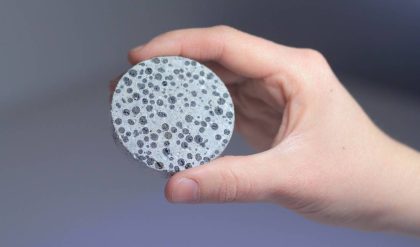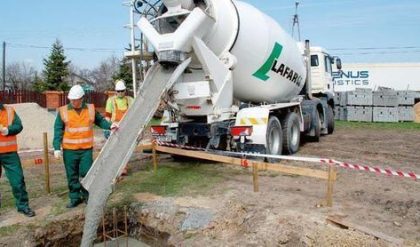Followings are some of the other properties of light weight aggregate concrete as compared to normal weight concrete:
1. For the same strength, the modulus of elasticity of light weight concrete is lower by 25 to 50% than normal concrete. Hence its deflections are greater.
2. Its resistance to freezing and thawing is greater than normal weight Concrete due to the greater porosity of light weight aggregate, provided the aggregate is not saturated before mixing.
3. Its fire resistance is greater as light weight aggregate have a lesser tendency to spall. Thus concrete suffers a lesser loss of strength due to rise in temperature.
4. It is easy to cut to fix desired attachments.
5. For the same compressive strength its shear strength is lower by 15 to 25% and bond strength is lower by 20 to 50%. Thus in the design of reinforced concrete beams these differences have to be taken into account.
6. The tensile strain capacity of light weight aggregate is greater than normal weight aggregate. Thus the tensile strain capacity of light weight aggregate concrete is about 50% greater than normal weight concrete. Hence the ability to withstand restraint to movement i.e. due to internal temperature gradient is greater for light weight concrete.
7. For the same strength the creep of light weight aggregate concrete is about the same as that of normal weight concrete.
Advantages of Light Weight Concrete:
Following are the advantages of light-weight-concrete:
1. Light weight concrete reduces the dead load of the structure.
2. It increases the progress of construction of the structure.
3. It lowers the haulage and handling charges.
4. The weight of structure on the foundation is an important factor in design, specially in the case of multi-story buildings and in weak soils. Heavier the dead load, deeper and thicker the foundations involving higher cost.
5. In framed structures, columns and beams have to carry loads of walls and floors. If walls and floor are made of light weight concrete, the foundations also will be lighter, resulting in considerable economy in the construction.
6. The thermal conductivity of light weight concrete is relatively low, which dampens the heat transfer from roof and walls, resulting lower inside temperature of the building. This lower temperature provides comfort to the inhabitants. The thermal conductivity improves with decrease in density.
7. In case of buildings where air conditioning is to be installed, the use of light weight concrete has been found advantageous from the point of view of thermal comfort and lower consumption of power.
Applications of Light Weight Concrete:
Light weight concrete can be used as follows:
1. As Load bearing masonry walls using cellular concrete blocks.
2. As precast floor and roof panels in all types of buildings.
3. As partition walls in all types of buildings as residential, industrial and institutional buildings.
4. As insulating materials to exterior walls in all types of buildings, specially in office and industrial buildings.
5. As a filler in the form of precast reinforced wall panels in multistoryed buildings.
6. As precast composite floor or wall panels etc.
Mix Proportion of Light Weight Concrete:
The water/cement ratio has the same influence on the strength of light weight aggregate concrete as that on normal aggregate concrete. Hence theoretically same procedure may be adopted for mix design as in the case of normal weight aggregate concrete. But in the absence of accurate values of absorption, specific gravity and free moisture content in the aggregate makes it difficult to apply the water/cement ratio law accurately for the mix proportion of light weight aggregate concrete.
Light weight aggregate produced artificially usually is bone dry. If it is saturated before mixing, the strength of the concrete will be lower by 5 to 10% than, dry aggregate is used for the same cement content and workability. In case of bone dry aggregate, some of the mixing water is absorbed after mixing, but before setting, reducing the effective water/cement ratio.
The density of concrete made with saturated aggregate is higher, but the resistance to freezing and thawing is reduced. On the other hand if the aggregate with high absorption is used without presoaking, it will be difficult to obtain workable and cohesive mix. In general, aggregate with more than 10% absorption should be presoaked and air entrainment should be done.
Thus the light weight concrete mix design usually is established by trial mixes. The proportion of fine to coarse aggregate and water and cement requirements are estimated on the previous experience with a particular aggregate. The different degrees of absorption by different light weight aggregates are one of the main difficulties in the design of mix proportions.
There are several methods to determine the aggregate content. Here the use of effective water/cement ratio for the calculation of aggregate content has been discussed. The method described here is based on the well-known British mix design method.
The steps involved to obtain the mix proportion for the stipulated 28 day strength are as follows:
Step 1:
The target mean strength of the concrete is determined from the characteristic strength, coefficient of probability and standard deviation as ft = fck + K.S.
Step 2:
The required water/cement ratio for the required target strength is determined from, the curve of Fig. 22.2

Step 3:
For the water-cement ratio obtained in step 2 the aggregate-cement ratio (by volume), cement content in kg/m and optimum percentage of fine aggregate for desired workability are selected from table 22.6 given below.

Step 4:
To obtain the effective free water content for the mix, the water content is adjusted for water absorption and the moisture content of aggregates.
Step 5:
For the data, obtained as above, a trial mix is prepared and water content is adjusted to maintain the desired workability. The density of fresh wet compacted concrete is calculated and cement content checked. If the cement content and density are not found correct, minor adjustment may be made either by adding or subtracting some quantity of cement and adding or subtracting some volume of fine aggregate as follows-




Comments are closed.